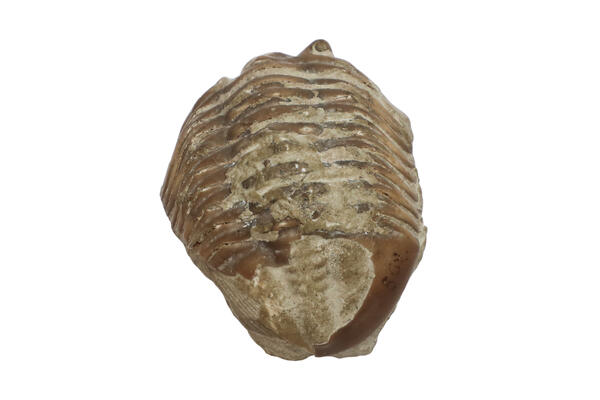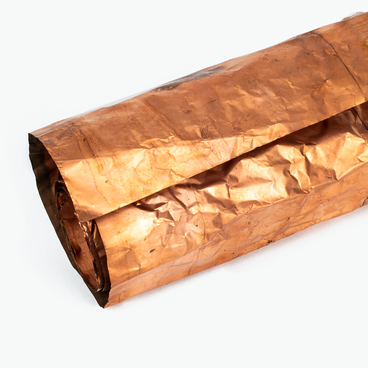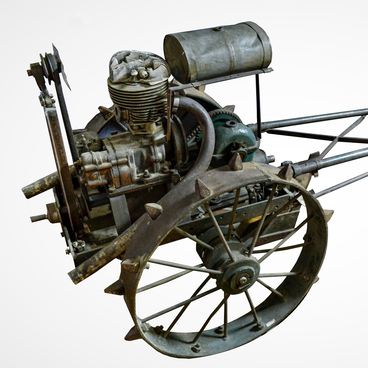The museum collection houses the fossilized remains of a trilobite — an arthropod that lived in the seas and oceans and became extinct more than 200 million years ago.
The elongated body of the trilobite was covered with a chitinous shell, very hard and resistant to external damage. It protected the internal organs of the animal.
The exoskeleton consisted of a head and tail shields, as well as a thorax. The threefold body structure gave the name to the animals. The mouth and legs of the trilobites were located on the bottom side, and the eyes — on the upper one.
The eyes of the trilobites were composed of the dense mineral calcite, so they have been well preserved. Scientists know that they were complex in structure and resembled the eyes of modern insects rather than those of marine animals.
Most trilobites crawled along the bottom or lived in silt and algae accumulations. There were also specimen that swam freely in open water. Trilobites fed on silt, plankton, and some of them were predators — they ate small invertebrates.
Trilobites lived throughout the Paleozoic era, which began 550 million years ago and ended about 250 million years ago. Their remains are found in limestone rocks and quarries, especially in the Leningrad region. Millions of years ago, there used to be a sea there, in which prehistoric animals had lived.
Most often, archaeologists find the tail parts of the shells called pygidia. Perhaps this is due to the fact that trilobites molted and shed their shell, which fell apart. Pygidium was the most durable element, so it has survived to this day.
Trilobites have remained on Earth only in the form of fossil remains. Therefore, in order to study their way of life, biologists observe their descendants — modern arthropods. They live in all regions, including the Arctic and Antarctic, and dwell on land, underground, in fresh and salt water, as well as in puddles and hot springs.
Arthropods not only adapted to the climate, but also mastered all types of food: there are predators, herbivores, parasites, filter feeders and those who collect dead organic matter. In addition, arthropods can feed on such difficult-to-digest substances as cellulose, wax, horn and consume oil hydrocarbons. Scientists believe they adapt well to their environment, that is why this animal species has existed for 500 million years.
The elongated body of the trilobite was covered with a chitinous shell, very hard and resistant to external damage. It protected the internal organs of the animal.
The exoskeleton consisted of a head and tail shields, as well as a thorax. The threefold body structure gave the name to the animals. The mouth and legs of the trilobites were located on the bottom side, and the eyes — on the upper one.
The eyes of the trilobites were composed of the dense mineral calcite, so they have been well preserved. Scientists know that they were complex in structure and resembled the eyes of modern insects rather than those of marine animals.
Most trilobites crawled along the bottom or lived in silt and algae accumulations. There were also specimen that swam freely in open water. Trilobites fed on silt, plankton, and some of them were predators — they ate small invertebrates.
Trilobites lived throughout the Paleozoic era, which began 550 million years ago and ended about 250 million years ago. Their remains are found in limestone rocks and quarries, especially in the Leningrad region. Millions of years ago, there used to be a sea there, in which prehistoric animals had lived.
Most often, archaeologists find the tail parts of the shells called pygidia. Perhaps this is due to the fact that trilobites molted and shed their shell, which fell apart. Pygidium was the most durable element, so it has survived to this day.
Trilobites have remained on Earth only in the form of fossil remains. Therefore, in order to study their way of life, biologists observe their descendants — modern arthropods. They live in all regions, including the Arctic and Antarctic, and dwell on land, underground, in fresh and salt water, as well as in puddles and hot springs.
Arthropods not only adapted to the climate, but also mastered all types of food: there are predators, herbivores, parasites, filter feeders and those who collect dead organic matter. In addition, arthropods can feed on such difficult-to-digest substances as cellulose, wax, horn and consume oil hydrocarbons. Scientists believe they adapt well to their environment, that is why this animal species has existed for 500 million years.



